Understanding the Diversity within Sunni, Sufi, Shia or Shiites Muslims
VerifiedAdded on 2023/01/16
|9
|2469
|62
AI Summary
This article explores the diversity within Sunni, Sufi, Shia or Shiites Muslims and the distinct belief systems they represent. It discusses the variations in interpretations, practices, and ideologies based on denomination, sect, culture, and religiosity. The article also examines the impact of sectarianism and the challenges faced by Islamic communities in achieving modernity and development. Overall, it highlights the importance of understanding the nuances and complexities within Islam.
Contribute Materials
Your contribution can guide someone’s learning journey. Share your
documents today.
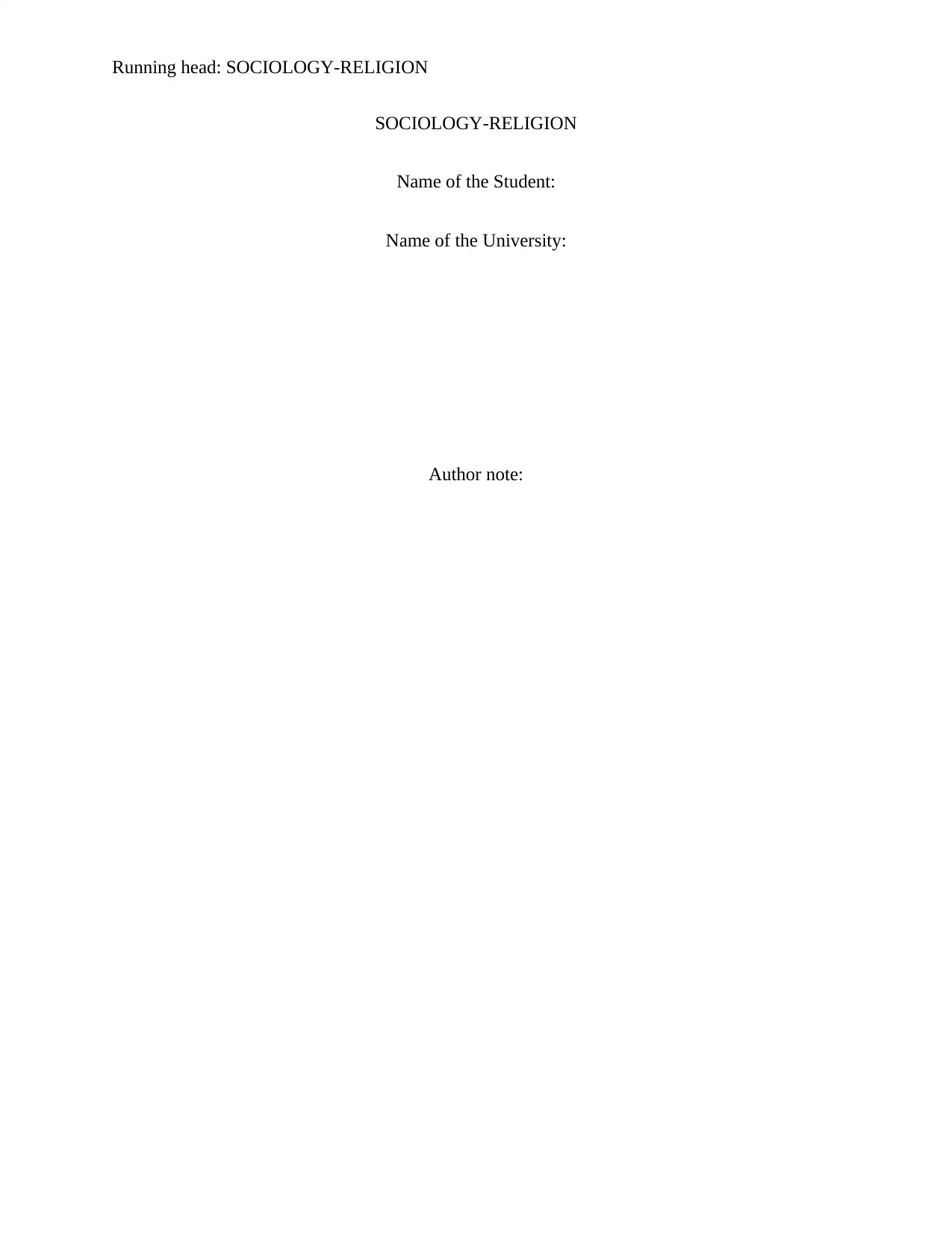
Running head: SOCIOLOGY-RELIGION
SOCIOLOGY-RELIGION
Name of the Student:
Name of the University:
Author note:
SOCIOLOGY-RELIGION
Name of the Student:
Name of the University:
Author note:
Secure Best Marks with AI Grader
Need help grading? Try our AI Grader for instant feedback on your assignments.

1SOCIOLOGY-RELIGION
Introduction
In the mainstream academic literature and media, the Islamic principles, value standards
and beliefs are often represented as a monolithic religion. Such a presentation of monolithic
religion tends to develop often by ignoring forms of internal diversity or heterogeneity on the
basis of denomination, ethnicity, and gender along with religious practices. According to Khalili
(2016), while there can be witnessed broad sects within Islam such as Sunni, Sufi, Shia or Shiites
(majority of them are distinguished from Shia Muslim community), the diversity within Islam
community tends to be much more nuanced and heterogeneous and further can be traced to
varied interpretations of the texts, judgements, opinions of narrators, jurisprudence along with
different interpretations, geographical location as well as diverse milieus where such
interpretations are enacted1. The paper will critically argue by focusing on the grounds to which
Sunni, Sufi, Shia or Shiites Muslims must be considered as a distinct belief systems.
Discussion
The monolithic perspective typically projected in mainstream media and academic
scholarship has been viewed to be problematic as Muslim beliefs, standards, practices along with
their interpretations tend to vary radically on the basis of denomination, sect, cultural as well as
ethnic practices, gender and religiosity. The significant number of Muslims currently in the
society is the Sunnis2. The emergence of the Arab uprisings has led Western nations to deal with
not only Islamist associations and factions but with the ones who are highly conventional
religious figures and have gradually emerged as significant players in the society. The significant
1 Khalili, Emad. "Sects in Islam: Sunnis and Shias." International Academic Journal of Humanities 3, no. 4 (2016):
41-47.
2 Nasr, Vali. The Shia Revival (Updates). WW norton & Company, 2016.
Introduction
In the mainstream academic literature and media, the Islamic principles, value standards
and beliefs are often represented as a monolithic religion. Such a presentation of monolithic
religion tends to develop often by ignoring forms of internal diversity or heterogeneity on the
basis of denomination, ethnicity, and gender along with religious practices. According to Khalili
(2016), while there can be witnessed broad sects within Islam such as Sunni, Sufi, Shia or Shiites
(majority of them are distinguished from Shia Muslim community), the diversity within Islam
community tends to be much more nuanced and heterogeneous and further can be traced to
varied interpretations of the texts, judgements, opinions of narrators, jurisprudence along with
different interpretations, geographical location as well as diverse milieus where such
interpretations are enacted1. The paper will critically argue by focusing on the grounds to which
Sunni, Sufi, Shia or Shiites Muslims must be considered as a distinct belief systems.
Discussion
The monolithic perspective typically projected in mainstream media and academic
scholarship has been viewed to be problematic as Muslim beliefs, standards, practices along with
their interpretations tend to vary radically on the basis of denomination, sect, cultural as well as
ethnic practices, gender and religiosity. The significant number of Muslims currently in the
society is the Sunnis2. The emergence of the Arab uprisings has led Western nations to deal with
not only Islamist associations and factions but with the ones who are highly conventional
religious figures and have gradually emerged as significant players in the society. The significant
1 Khalili, Emad. "Sects in Islam: Sunnis and Shias." International Academic Journal of Humanities 3, no. 4 (2016):
41-47.
2 Nasr, Vali. The Shia Revival (Updates). WW norton & Company, 2016.

2SOCIOLOGY-RELIGION
wave of the Arab uprisings has embedded ethnic as well as religious tensions between Sunni and
Shiites which have been substantially constituted in recent years and however have been pushed
once again to the front. Furthermore, comprehensive studies have noted that the rise of
sectarianism has been primarily driven by three major factors3. Firstly, Sunni Islamist
ascendancy in Tunisia and specifically in Egyptian nation has reignited the sectarian flame which
has periodically hovered over the societies of Middle East. However, considering the
disagreements and contradictions among Shia, Sunni and Sufi Muslims, these implications have
led them to be a victim of Salafi and Deobandi militancy of anti-social groups related to Al-
Qaeda, ISIS, Al Shabab in addition to other militant groups. Drawing relevance to these factors,
Alak (2015) has shed light on the importance of society to comprehend range of ideologies and
beliefs produced by different Muslim communities4.
Meanwhile, Venetis (2014) has noted that democracy buildings have remained as a
critical conflict among world Muslim communities. However, development in liberalizing
societies along with modernizing institutions has been immensely slow due to continual conflict
among Sunni and Shia Muslims5. Isa, Haruna and Haruna (2018) have noted that majority of
Islamic communities have been at impasse. Consequently, dysfunctional, violence and repressive
states of the communities have thus been exhibiting incompetence of reformation. According to
Khalili (2016), these Islamic communities in the developing nation are driven by immense needs
and demands of a passionate quest for attaining modernity, expansion, development as well as
3 Zaidon, Ahmad, and Iman Jafarian. "Impediments of Political Development and International threats in Yemen." J.
Hum. Ins2, no. 3 (2018): 220-223.
4 Alak, Alina Isac. "Types of religious identities within Romanian Muslim communities." Journal for the Study of
Religions and Ideologies 14, no. 41 (2015): 148-173.
5 Socialstudies.org. 2019. "Islam: Sunnis And Shiites". Socialstudies.Org.
http://www.socialstudies.org/sites/default/files/publications/se/5806/580602.html.
wave of the Arab uprisings has embedded ethnic as well as religious tensions between Sunni and
Shiites which have been substantially constituted in recent years and however have been pushed
once again to the front. Furthermore, comprehensive studies have noted that the rise of
sectarianism has been primarily driven by three major factors3. Firstly, Sunni Islamist
ascendancy in Tunisia and specifically in Egyptian nation has reignited the sectarian flame which
has periodically hovered over the societies of Middle East. However, considering the
disagreements and contradictions among Shia, Sunni and Sufi Muslims, these implications have
led them to be a victim of Salafi and Deobandi militancy of anti-social groups related to Al-
Qaeda, ISIS, Al Shabab in addition to other militant groups. Drawing relevance to these factors,
Alak (2015) has shed light on the importance of society to comprehend range of ideologies and
beliefs produced by different Muslim communities4.
Meanwhile, Venetis (2014) has noted that democracy buildings have remained as a
critical conflict among world Muslim communities. However, development in liberalizing
societies along with modernizing institutions has been immensely slow due to continual conflict
among Sunni and Shia Muslims5. Isa, Haruna and Haruna (2018) have noted that majority of
Islamic communities have been at impasse. Consequently, dysfunctional, violence and repressive
states of the communities have thus been exhibiting incompetence of reformation. According to
Khalili (2016), these Islamic communities in the developing nation are driven by immense needs
and demands of a passionate quest for attaining modernity, expansion, development as well as
3 Zaidon, Ahmad, and Iman Jafarian. "Impediments of Political Development and International threats in Yemen." J.
Hum. Ins2, no. 3 (2018): 220-223.
4 Alak, Alina Isac. "Types of religious identities within Romanian Muslim communities." Journal for the Study of
Religions and Ideologies 14, no. 41 (2015): 148-173.
5 Socialstudies.org. 2019. "Islam: Sunnis And Shiites". Socialstudies.Org.
http://www.socialstudies.org/sites/default/files/publications/se/5806/580602.html.
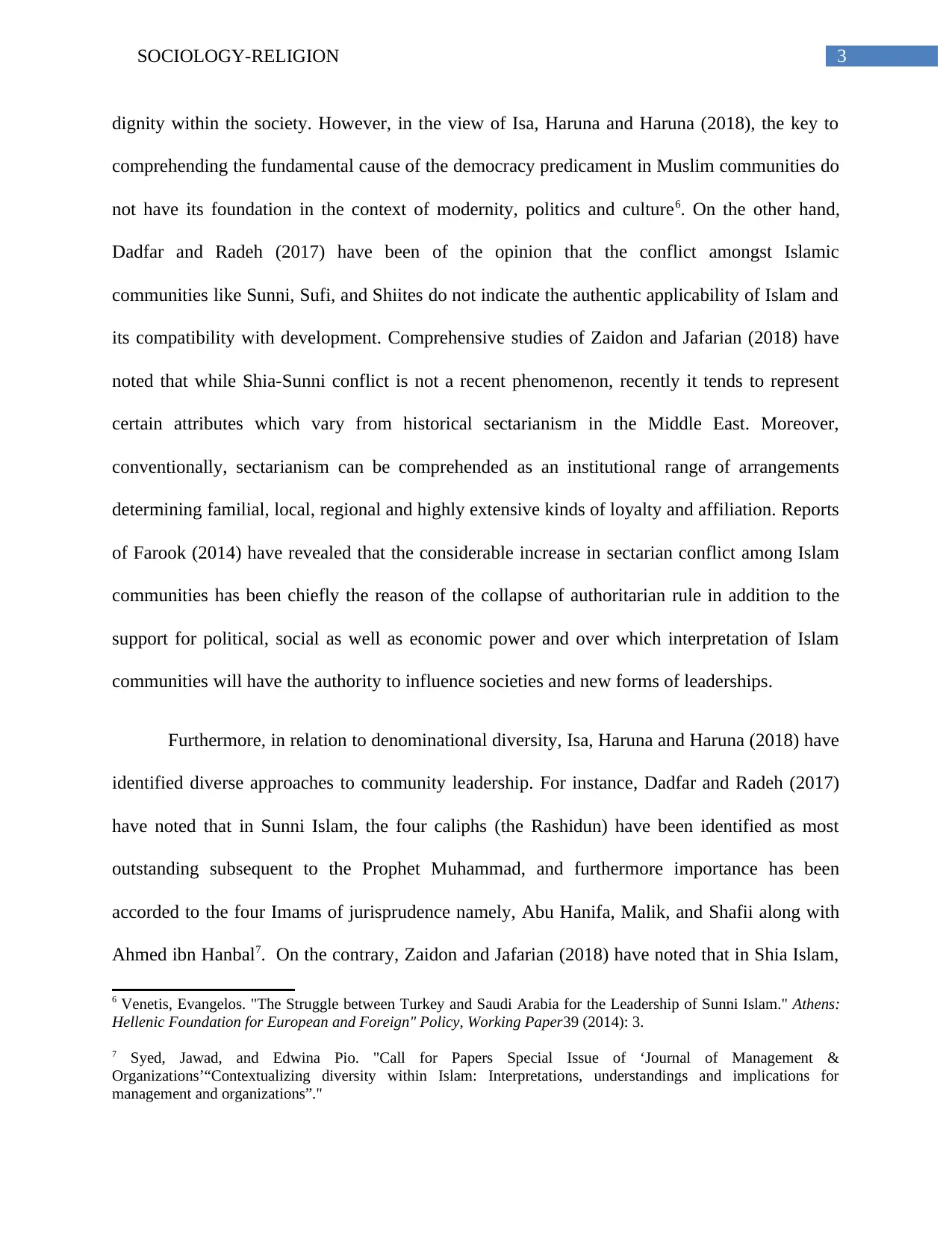
3SOCIOLOGY-RELIGION
dignity within the society. However, in the view of Isa, Haruna and Haruna (2018), the key to
comprehending the fundamental cause of the democracy predicament in Muslim communities do
not have its foundation in the context of modernity, politics and culture6. On the other hand,
Dadfar and Radeh (2017) have been of the opinion that the conflict amongst Islamic
communities like Sunni, Sufi, and Shiites do not indicate the authentic applicability of Islam and
its compatibility with development. Comprehensive studies of Zaidon and Jafarian (2018) have
noted that while Shia-Sunni conflict is not a recent phenomenon, recently it tends to represent
certain attributes which vary from historical sectarianism in the Middle East. Moreover,
conventionally, sectarianism can be comprehended as an institutional range of arrangements
determining familial, local, regional and highly extensive kinds of loyalty and affiliation. Reports
of Farook (2014) have revealed that the considerable increase in sectarian conflict among Islam
communities has been chiefly the reason of the collapse of authoritarian rule in addition to the
support for political, social as well as economic power and over which interpretation of Islam
communities will have the authority to influence societies and new forms of leaderships.
Furthermore, in relation to denominational diversity, Isa, Haruna and Haruna (2018) have
identified diverse approaches to community leadership. For instance, Dadfar and Radeh (2017)
have noted that in Sunni Islam, the four caliphs (the Rashidun) have been identified as most
outstanding subsequent to the Prophet Muhammad, and furthermore importance has been
accorded to the four Imams of jurisprudence namely, Abu Hanifa, Malik, and Shafii along with
Ahmed ibn Hanbal7. On the contrary, Zaidon and Jafarian (2018) have noted that in Shia Islam,
6 Venetis, Evangelos. "The Struggle between Turkey and Saudi Arabia for the Leadership of Sunni Islam." Athens:
Hellenic Foundation for European and Foreign" Policy, Working Paper39 (2014): 3.
7 Syed, Jawad, and Edwina Pio. "Call for Papers Special Issue of ‘Journal of Management &
Organizations’“Contextualizing diversity within Islam: Interpretations, understandings and implications for
management and organizations”."
dignity within the society. However, in the view of Isa, Haruna and Haruna (2018), the key to
comprehending the fundamental cause of the democracy predicament in Muslim communities do
not have its foundation in the context of modernity, politics and culture6. On the other hand,
Dadfar and Radeh (2017) have been of the opinion that the conflict amongst Islamic
communities like Sunni, Sufi, and Shiites do not indicate the authentic applicability of Islam and
its compatibility with development. Comprehensive studies of Zaidon and Jafarian (2018) have
noted that while Shia-Sunni conflict is not a recent phenomenon, recently it tends to represent
certain attributes which vary from historical sectarianism in the Middle East. Moreover,
conventionally, sectarianism can be comprehended as an institutional range of arrangements
determining familial, local, regional and highly extensive kinds of loyalty and affiliation. Reports
of Farook (2014) have revealed that the considerable increase in sectarian conflict among Islam
communities has been chiefly the reason of the collapse of authoritarian rule in addition to the
support for political, social as well as economic power and over which interpretation of Islam
communities will have the authority to influence societies and new forms of leaderships.
Furthermore, in relation to denominational diversity, Isa, Haruna and Haruna (2018) have
identified diverse approaches to community leadership. For instance, Dadfar and Radeh (2017)
have noted that in Sunni Islam, the four caliphs (the Rashidun) have been identified as most
outstanding subsequent to the Prophet Muhammad, and furthermore importance has been
accorded to the four Imams of jurisprudence namely, Abu Hanifa, Malik, and Shafii along with
Ahmed ibn Hanbal7. On the contrary, Zaidon and Jafarian (2018) have noted that in Shia Islam,
6 Venetis, Evangelos. "The Struggle between Turkey and Saudi Arabia for the Leadership of Sunni Islam." Athens:
Hellenic Foundation for European and Foreign" Policy, Working Paper39 (2014): 3.
7 Syed, Jawad, and Edwina Pio. "Call for Papers Special Issue of ‘Journal of Management &
Organizations’“Contextualizing diversity within Islam: Interpretations, understandings and implications for
management and organizations”."
Secure Best Marks with AI Grader
Need help grading? Try our AI Grader for instant feedback on your assignments.
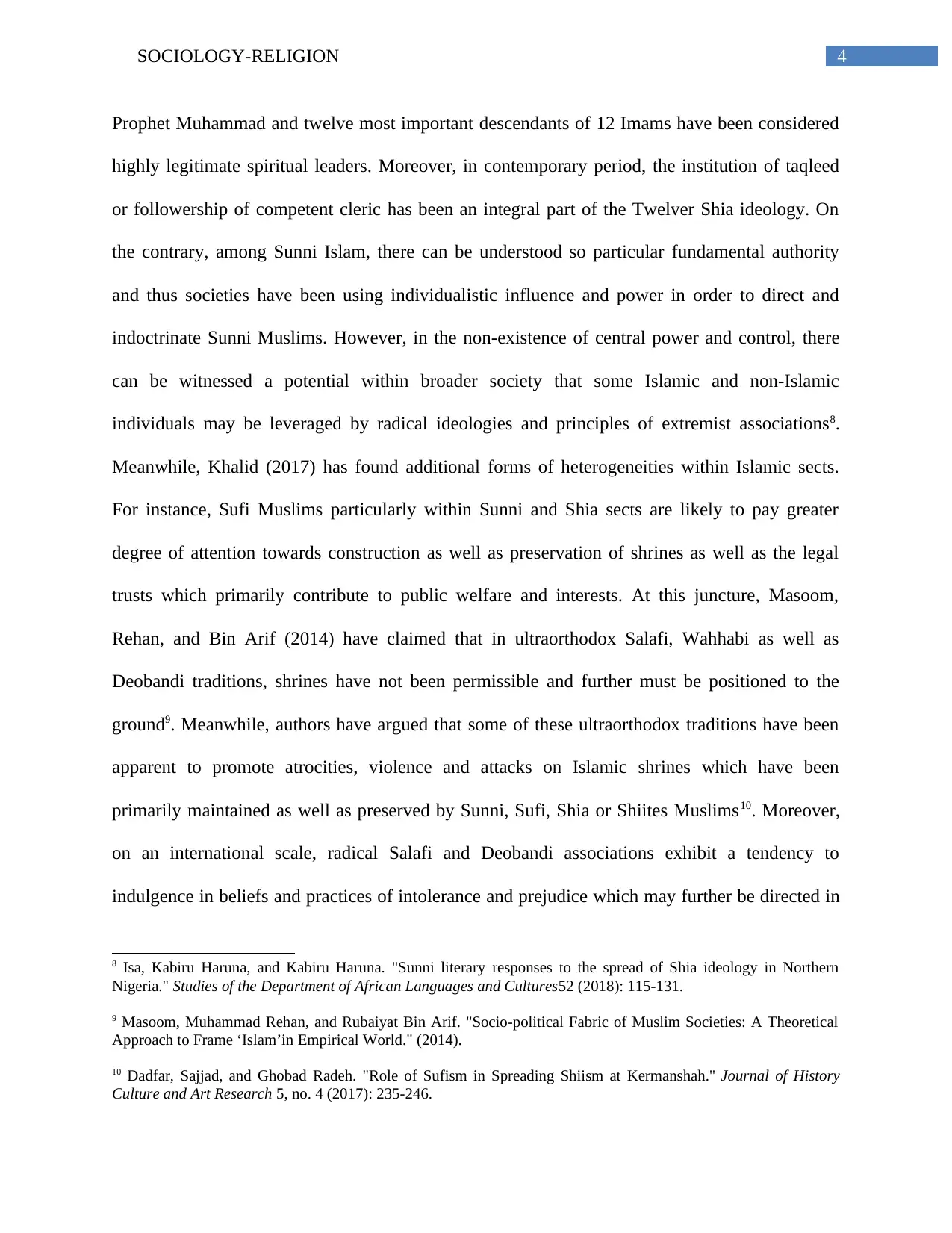
4SOCIOLOGY-RELIGION
Prophet Muhammad and twelve most important descendants of 12 Imams have been considered
highly legitimate spiritual leaders. Moreover, in contemporary period, the institution of taqleed
or followership of competent cleric has been an integral part of the Twelver Shia ideology. On
the contrary, among Sunni Islam, there can be understood so particular fundamental authority
and thus societies have been using individualistic influence and power in order to direct and
indoctrinate Sunni Muslims. However, in the non-existence of central power and control, there
can be witnessed a potential within broader society that some Islamic and non-Islamic
individuals may be leveraged by radical ideologies and principles of extremist associations8.
Meanwhile, Khalid (2017) has found additional forms of heterogeneities within Islamic sects.
For instance, Sufi Muslims particularly within Sunni and Shia sects are likely to pay greater
degree of attention towards construction as well as preservation of shrines as well as the legal
trusts which primarily contribute to public welfare and interests. At this juncture, Masoom,
Rehan, and Bin Arif (2014) have claimed that in ultraorthodox Salafi, Wahhabi as well as
Deobandi traditions, shrines have not been permissible and further must be positioned to the
ground9. Meanwhile, authors have argued that some of these ultraorthodox traditions have been
apparent to promote atrocities, violence and attacks on Islamic shrines which have been
primarily maintained as well as preserved by Sunni, Sufi, Shia or Shiites Muslims10. Moreover,
on an international scale, radical Salafi and Deobandi associations exhibit a tendency to
indulgence in beliefs and practices of intolerance and prejudice which may further be directed in
8 Isa, Kabiru Haruna, and Kabiru Haruna. "Sunni literary responses to the spread of Shia ideology in Northern
Nigeria." Studies of the Department of African Languages and Cultures52 (2018): 115-131.
9 Masoom, Muhammad Rehan, and Rubaiyat Bin Arif. "Socio-political Fabric of Muslim Societies: A Theoretical
Approach to Frame ‘Islam’in Empirical World." (2014).
10 Dadfar, Sajjad, and Ghobad Radeh. "Role of Sufism in Spreading Shiism at Kermanshah." Journal of History
Culture and Art Research 5, no. 4 (2017): 235-246.
Prophet Muhammad and twelve most important descendants of 12 Imams have been considered
highly legitimate spiritual leaders. Moreover, in contemporary period, the institution of taqleed
or followership of competent cleric has been an integral part of the Twelver Shia ideology. On
the contrary, among Sunni Islam, there can be understood so particular fundamental authority
and thus societies have been using individualistic influence and power in order to direct and
indoctrinate Sunni Muslims. However, in the non-existence of central power and control, there
can be witnessed a potential within broader society that some Islamic and non-Islamic
individuals may be leveraged by radical ideologies and principles of extremist associations8.
Meanwhile, Khalid (2017) has found additional forms of heterogeneities within Islamic sects.
For instance, Sufi Muslims particularly within Sunni and Shia sects are likely to pay greater
degree of attention towards construction as well as preservation of shrines as well as the legal
trusts which primarily contribute to public welfare and interests. At this juncture, Masoom,
Rehan, and Bin Arif (2014) have claimed that in ultraorthodox Salafi, Wahhabi as well as
Deobandi traditions, shrines have not been permissible and further must be positioned to the
ground9. Meanwhile, authors have argued that some of these ultraorthodox traditions have been
apparent to promote atrocities, violence and attacks on Islamic shrines which have been
primarily maintained as well as preserved by Sunni, Sufi, Shia or Shiites Muslims10. Moreover,
on an international scale, radical Salafi and Deobandi associations exhibit a tendency to
indulgence in beliefs and practices of intolerance and prejudice which may further be directed in
8 Isa, Kabiru Haruna, and Kabiru Haruna. "Sunni literary responses to the spread of Shia ideology in Northern
Nigeria." Studies of the Department of African Languages and Cultures52 (2018): 115-131.
9 Masoom, Muhammad Rehan, and Rubaiyat Bin Arif. "Socio-political Fabric of Muslim Societies: A Theoretical
Approach to Frame ‘Islam’in Empirical World." (2014).
10 Dadfar, Sajjad, and Ghobad Radeh. "Role of Sufism in Spreading Shiism at Kermanshah." Journal of History
Culture and Art Research 5, no. 4 (2017): 235-246.
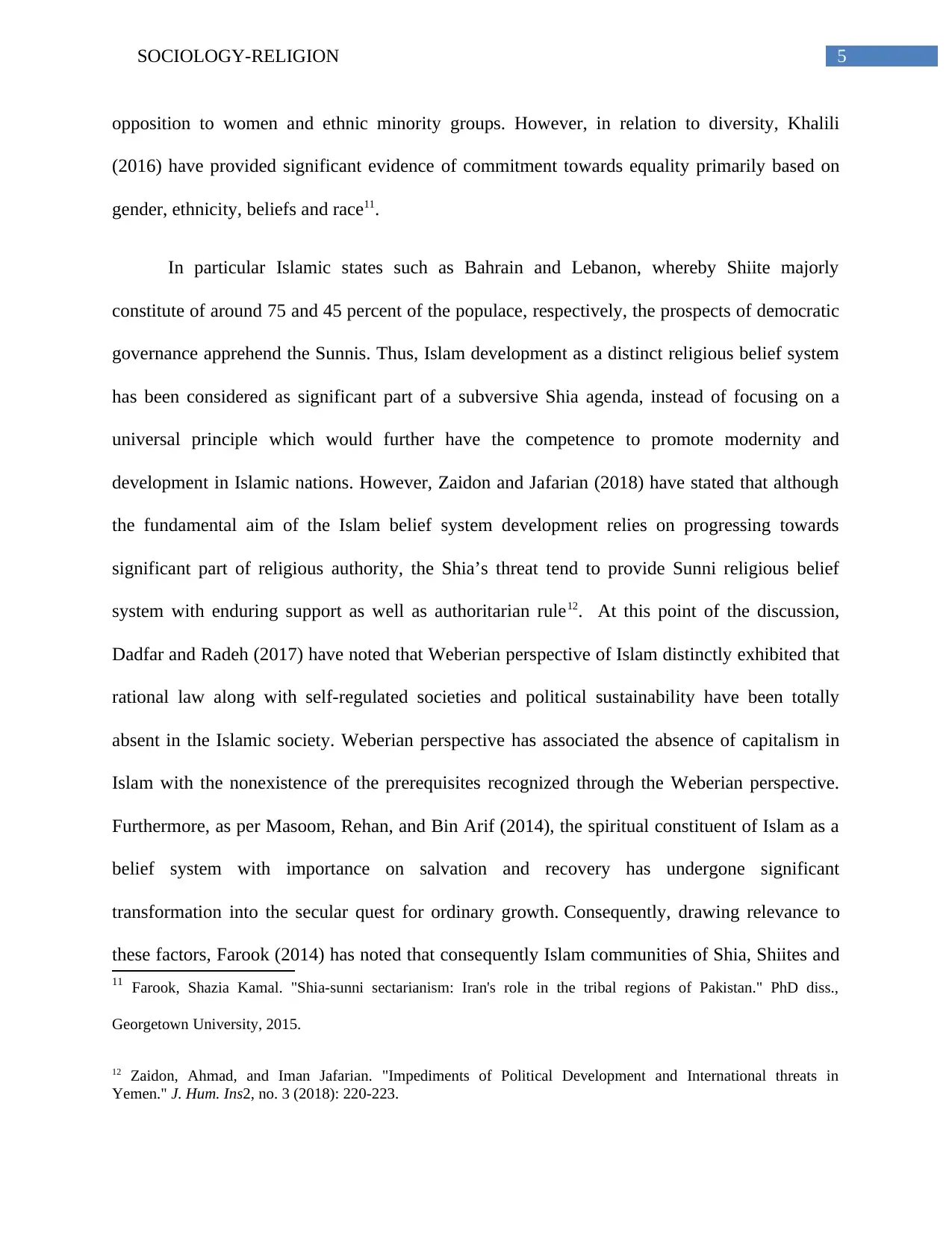
5SOCIOLOGY-RELIGION
opposition to women and ethnic minority groups. However, in relation to diversity, Khalili
(2016) have provided significant evidence of commitment towards equality primarily based on
gender, ethnicity, beliefs and race11.
In particular Islamic states such as Bahrain and Lebanon, whereby Shiite majorly
constitute of around 75 and 45 percent of the populace, respectively, the prospects of democratic
governance apprehend the Sunnis. Thus, Islam development as a distinct religious belief system
has been considered as significant part of a subversive Shia agenda, instead of focusing on a
universal principle which would further have the competence to promote modernity and
development in Islamic nations. However, Zaidon and Jafarian (2018) have stated that although
the fundamental aim of the Islam belief system development relies on progressing towards
significant part of religious authority, the Shia’s threat tend to provide Sunni religious belief
system with enduring support as well as authoritarian rule12. At this point of the discussion,
Dadfar and Radeh (2017) have noted that Weberian perspective of Islam distinctly exhibited that
rational law along with self-regulated societies and political sustainability have been totally
absent in the Islamic society. Weberian perspective has associated the absence of capitalism in
Islam with the nonexistence of the prerequisites recognized through the Weberian perspective.
Furthermore, as per Masoom, Rehan, and Bin Arif (2014), the spiritual constituent of Islam as a
belief system with importance on salvation and recovery has undergone significant
transformation into the secular quest for ordinary growth. Consequently, drawing relevance to
these factors, Farook (2014) has noted that consequently Islam communities of Shia, Shiites and
11 Farook, Shazia Kamal. "Shia-sunni sectarianism: Iran's role in the tribal regions of Pakistan." PhD diss.,
Georgetown University, 2015.
12 Zaidon, Ahmad, and Iman Jafarian. "Impediments of Political Development and International threats in
Yemen." J. Hum. Ins2, no. 3 (2018): 220-223.
opposition to women and ethnic minority groups. However, in relation to diversity, Khalili
(2016) have provided significant evidence of commitment towards equality primarily based on
gender, ethnicity, beliefs and race11.
In particular Islamic states such as Bahrain and Lebanon, whereby Shiite majorly
constitute of around 75 and 45 percent of the populace, respectively, the prospects of democratic
governance apprehend the Sunnis. Thus, Islam development as a distinct religious belief system
has been considered as significant part of a subversive Shia agenda, instead of focusing on a
universal principle which would further have the competence to promote modernity and
development in Islamic nations. However, Zaidon and Jafarian (2018) have stated that although
the fundamental aim of the Islam belief system development relies on progressing towards
significant part of religious authority, the Shia’s threat tend to provide Sunni religious belief
system with enduring support as well as authoritarian rule12. At this point of the discussion,
Dadfar and Radeh (2017) have noted that Weberian perspective of Islam distinctly exhibited that
rational law along with self-regulated societies and political sustainability have been totally
absent in the Islamic society. Weberian perspective has associated the absence of capitalism in
Islam with the nonexistence of the prerequisites recognized through the Weberian perspective.
Furthermore, as per Masoom, Rehan, and Bin Arif (2014), the spiritual constituent of Islam as a
belief system with importance on salvation and recovery has undergone significant
transformation into the secular quest for ordinary growth. Consequently, drawing relevance to
these factors, Farook (2014) has noted that consequently Islam communities of Shia, Shiites and
11 Farook, Shazia Kamal. "Shia-sunni sectarianism: Iran's role in the tribal regions of Pakistan." PhD diss.,
Georgetown University, 2015.
12 Zaidon, Ahmad, and Iman Jafarian. "Impediments of Political Development and International threats in
Yemen." J. Hum. Ins2, no. 3 (2018): 220-223.
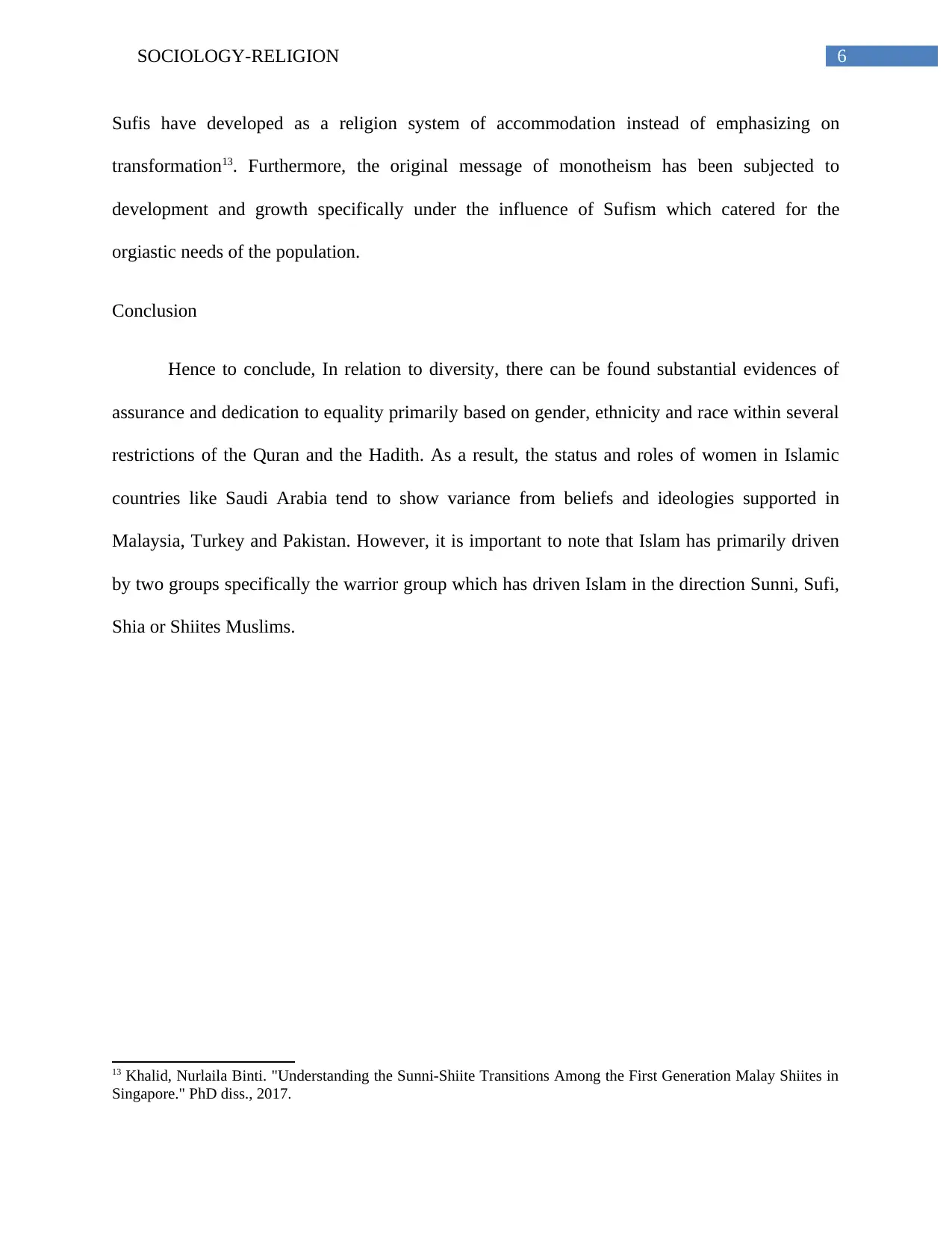
6SOCIOLOGY-RELIGION
Sufis have developed as a religion system of accommodation instead of emphasizing on
transformation13. Furthermore, the original message of monotheism has been subjected to
development and growth specifically under the influence of Sufism which catered for the
orgiastic needs of the population.
Conclusion
Hence to conclude, In relation to diversity, there can be found substantial evidences of
assurance and dedication to equality primarily based on gender, ethnicity and race within several
restrictions of the Quran and the Hadith. As a result, the status and roles of women in Islamic
countries like Saudi Arabia tend to show variance from beliefs and ideologies supported in
Malaysia, Turkey and Pakistan. However, it is important to note that Islam has primarily driven
by two groups specifically the warrior group which has driven Islam in the direction Sunni, Sufi,
Shia or Shiites Muslims.
13 Khalid, Nurlaila Binti. "Understanding the Sunni-Shiite Transitions Among the First Generation Malay Shiites in
Singapore." PhD diss., 2017.
Sufis have developed as a religion system of accommodation instead of emphasizing on
transformation13. Furthermore, the original message of monotheism has been subjected to
development and growth specifically under the influence of Sufism which catered for the
orgiastic needs of the population.
Conclusion
Hence to conclude, In relation to diversity, there can be found substantial evidences of
assurance and dedication to equality primarily based on gender, ethnicity and race within several
restrictions of the Quran and the Hadith. As a result, the status and roles of women in Islamic
countries like Saudi Arabia tend to show variance from beliefs and ideologies supported in
Malaysia, Turkey and Pakistan. However, it is important to note that Islam has primarily driven
by two groups specifically the warrior group which has driven Islam in the direction Sunni, Sufi,
Shia or Shiites Muslims.
13 Khalid, Nurlaila Binti. "Understanding the Sunni-Shiite Transitions Among the First Generation Malay Shiites in
Singapore." PhD diss., 2017.
Paraphrase This Document
Need a fresh take? Get an instant paraphrase of this document with our AI Paraphraser
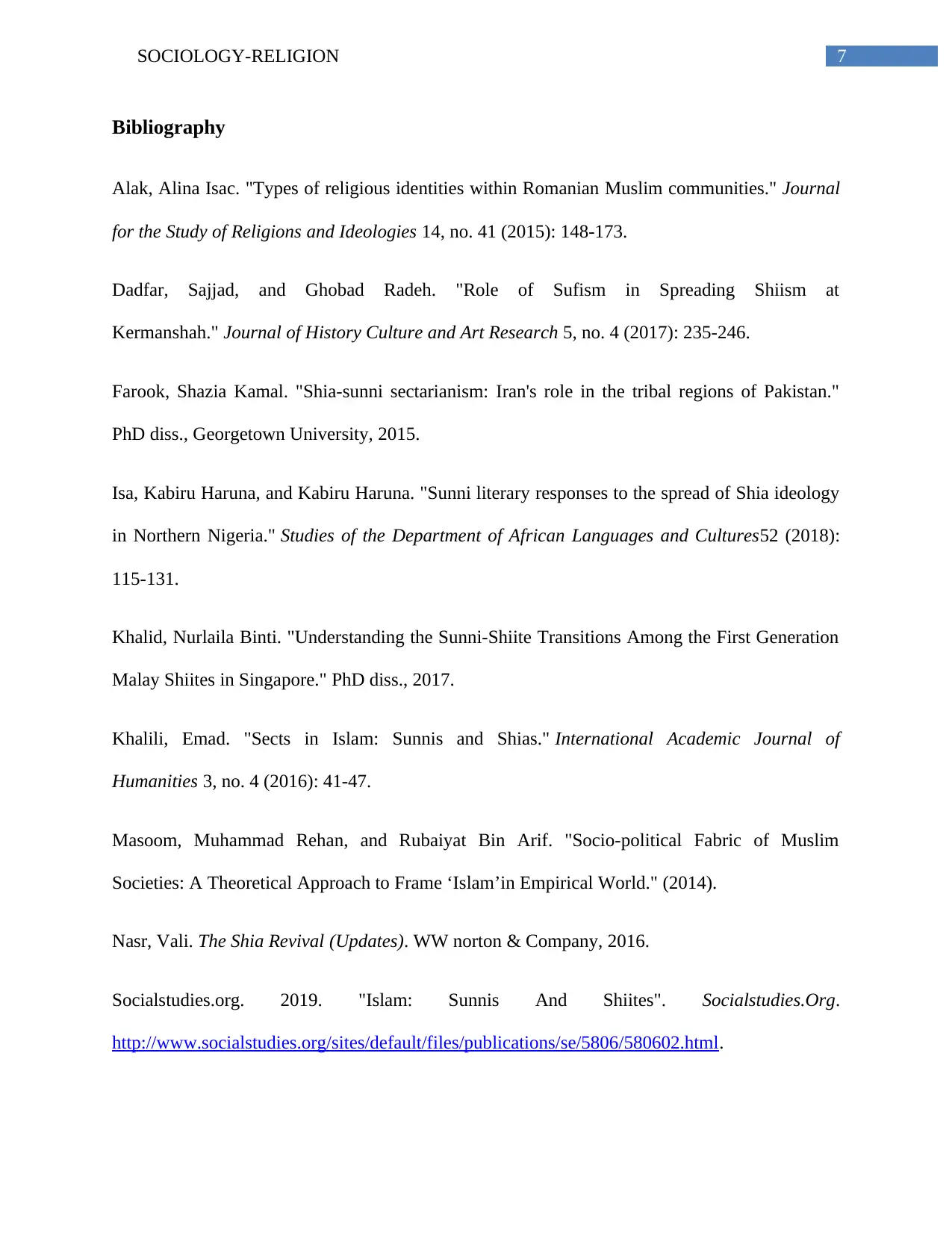
7SOCIOLOGY-RELIGION
Bibliography
Alak, Alina Isac. "Types of religious identities within Romanian Muslim communities." Journal
for the Study of Religions and Ideologies 14, no. 41 (2015): 148-173.
Dadfar, Sajjad, and Ghobad Radeh. "Role of Sufism in Spreading Shiism at
Kermanshah." Journal of History Culture and Art Research 5, no. 4 (2017): 235-246.
Farook, Shazia Kamal. "Shia-sunni sectarianism: Iran's role in the tribal regions of Pakistan."
PhD diss., Georgetown University, 2015.
Isa, Kabiru Haruna, and Kabiru Haruna. "Sunni literary responses to the spread of Shia ideology
in Northern Nigeria." Studies of the Department of African Languages and Cultures52 (2018):
115-131.
Khalid, Nurlaila Binti. "Understanding the Sunni-Shiite Transitions Among the First Generation
Malay Shiites in Singapore." PhD diss., 2017.
Khalili, Emad. "Sects in Islam: Sunnis and Shias." International Academic Journal of
Humanities 3, no. 4 (2016): 41-47.
Masoom, Muhammad Rehan, and Rubaiyat Bin Arif. "Socio-political Fabric of Muslim
Societies: A Theoretical Approach to Frame ‘Islam’in Empirical World." (2014).
Nasr, Vali. The Shia Revival (Updates). WW norton & Company, 2016.
Socialstudies.org. 2019. "Islam: Sunnis And Shiites". Socialstudies.Org.
http://www.socialstudies.org/sites/default/files/publications/se/5806/580602.html.
Bibliography
Alak, Alina Isac. "Types of religious identities within Romanian Muslim communities." Journal
for the Study of Religions and Ideologies 14, no. 41 (2015): 148-173.
Dadfar, Sajjad, and Ghobad Radeh. "Role of Sufism in Spreading Shiism at
Kermanshah." Journal of History Culture and Art Research 5, no. 4 (2017): 235-246.
Farook, Shazia Kamal. "Shia-sunni sectarianism: Iran's role in the tribal regions of Pakistan."
PhD diss., Georgetown University, 2015.
Isa, Kabiru Haruna, and Kabiru Haruna. "Sunni literary responses to the spread of Shia ideology
in Northern Nigeria." Studies of the Department of African Languages and Cultures52 (2018):
115-131.
Khalid, Nurlaila Binti. "Understanding the Sunni-Shiite Transitions Among the First Generation
Malay Shiites in Singapore." PhD diss., 2017.
Khalili, Emad. "Sects in Islam: Sunnis and Shias." International Academic Journal of
Humanities 3, no. 4 (2016): 41-47.
Masoom, Muhammad Rehan, and Rubaiyat Bin Arif. "Socio-political Fabric of Muslim
Societies: A Theoretical Approach to Frame ‘Islam’in Empirical World." (2014).
Nasr, Vali. The Shia Revival (Updates). WW norton & Company, 2016.
Socialstudies.org. 2019. "Islam: Sunnis And Shiites". Socialstudies.Org.
http://www.socialstudies.org/sites/default/files/publications/se/5806/580602.html.
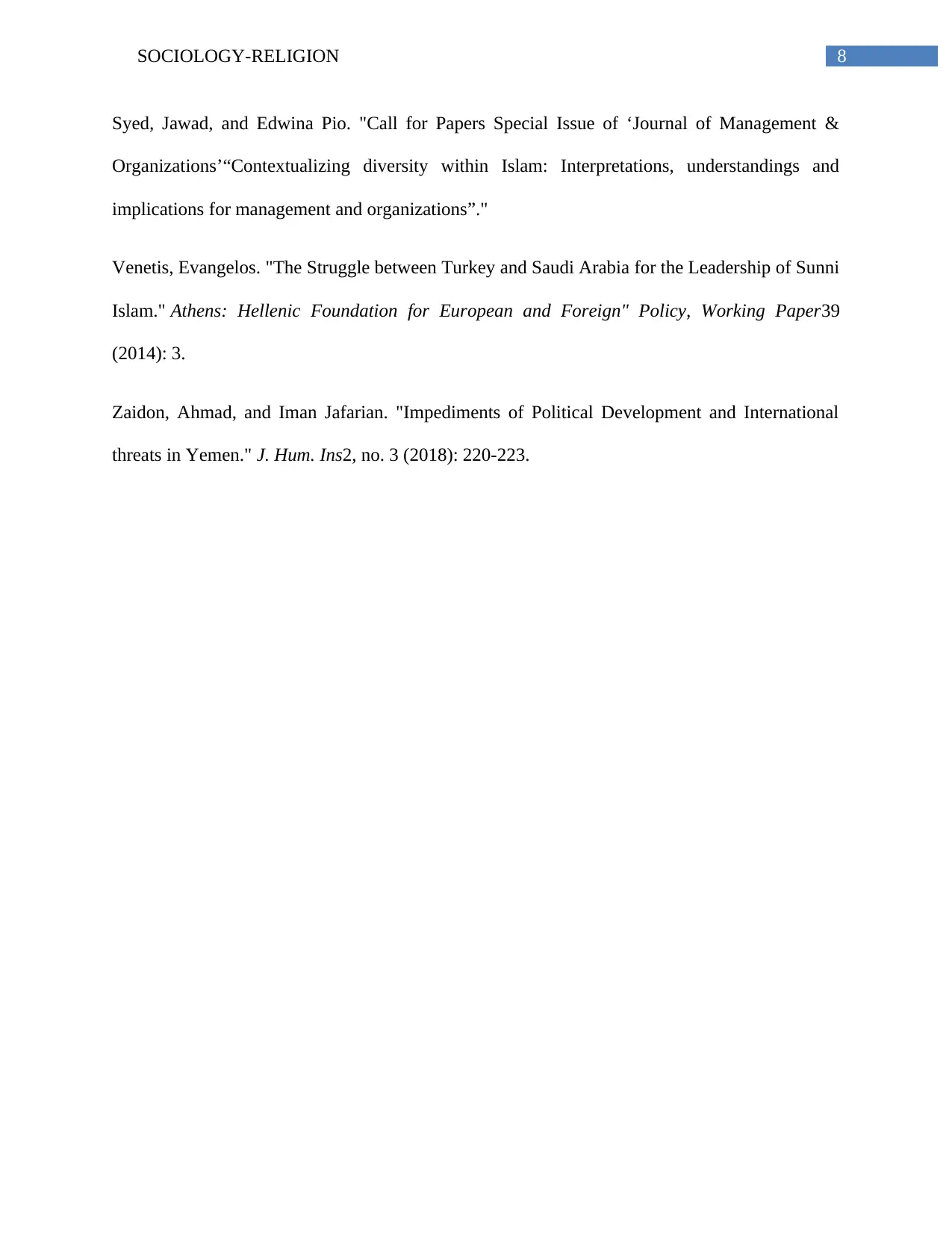
8SOCIOLOGY-RELIGION
Syed, Jawad, and Edwina Pio. "Call for Papers Special Issue of ‘Journal of Management &
Organizations’“Contextualizing diversity within Islam: Interpretations, understandings and
implications for management and organizations”."
Venetis, Evangelos. "The Struggle between Turkey and Saudi Arabia for the Leadership of Sunni
Islam." Athens: Hellenic Foundation for European and Foreign" Policy, Working Paper39
(2014): 3.
Zaidon, Ahmad, and Iman Jafarian. "Impediments of Political Development and International
threats in Yemen." J. Hum. Ins2, no. 3 (2018): 220-223.
Syed, Jawad, and Edwina Pio. "Call for Papers Special Issue of ‘Journal of Management &
Organizations’“Contextualizing diversity within Islam: Interpretations, understandings and
implications for management and organizations”."
Venetis, Evangelos. "The Struggle between Turkey and Saudi Arabia for the Leadership of Sunni
Islam." Athens: Hellenic Foundation for European and Foreign" Policy, Working Paper39
(2014): 3.
Zaidon, Ahmad, and Iman Jafarian. "Impediments of Political Development and International
threats in Yemen." J. Hum. Ins2, no. 3 (2018): 220-223.
1 out of 9
Your All-in-One AI-Powered Toolkit for Academic Success.
+13062052269
info@desklib.com
Available 24*7 on WhatsApp / Email
![[object Object]](/_next/static/media/star-bottom.7253800d.svg)
Unlock your academic potential
© 2024 | Zucol Services PVT LTD | All rights reserved.
